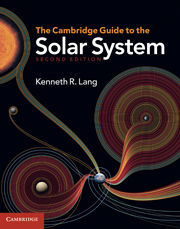Book contents
- Frontmatter
- Contents
- List of focus elements
- List of tables
- Preface to the second edition
- Preface to the first edition
- Principal units
- Part 1 Changing views and fundamental concepts
- 1 Evolving perspectives: a historical prologue
- 2 The new close-up view from space
- 3 Atmospheres, magnetospheres and the solar wind
- Part 2 The inner solar system: rocky worlds
- Part 3 The giant planets, their satellites and their rings: worlds of liquid, ice and gas
- Part 4 Remnants of creation: small worlds in the solar system
- Part 5 Origin of the solar system and extrasolar planets
- Author index
- Subject index
3 - Atmospheres, magnetospheres and the solar wind
from Part 1 - Changing views and fundamental concepts
Published online by Cambridge University Press: 05 August 2011
- Frontmatter
- Contents
- List of focus elements
- List of tables
- Preface to the second edition
- Preface to the first edition
- Principal units
- Part 1 Changing views and fundamental concepts
- 1 Evolving perspectives: a historical prologue
- 2 The new close-up view from space
- 3 Atmospheres, magnetospheres and the solar wind
- Part 2 The inner solar system: rocky worlds
- Part 3 The giant planets, their satellites and their rings: worlds of liquid, ice and gas
- Part 4 Remnants of creation: small worlds in the solar system
- Part 5 Origin of the solar system and extrasolar planets
- Author index
- Subject index
Summary
• An atmosphere is a gaseous layer of molecules, with smaller amounts of atoms and ions, which surrounds a planet or natural satellite, held near them by their gravity.
• The present-day atmospheres of the terrestrial planets are thought to be secondary, having originated after planetary formation about 4.6 billion years ago. The atmospheres may have been released from volcanoes or acquired during collisions of comets and asteroids.
• The giant planets retain their primeval atmospheres, created when these planets formed, capturing significant amounts of hydrogen and helium gas.
• An atmosphere is characterized by the pressure and temperature of the molecules in it.
• Pressure increases with the temperature and density of the gas.
• An atmosphere allows the warmth of sunlight in but prevents the escape of infrared heat radiation from the planet's surface; this global warming by heat-trapping gases in an atmosphere is now known as the greenhouse effect.
• The ability of a planet or satellite to retain an atmosphere depends on both the temperature of that atmosphere and the gravitational pull of the planet or satellite. If the gas is hot, the molecules move about with a greater velocity and are more likely to escape the gravitational pull of the planet. A planet with a larger mass is more likely to retain an atmosphere.
• Only the massive giant planets, like Jupiter and Saturn, have a high enough escape velocity that they can retain all atoms and molecules, including the lightest element, hydrogen. […]
- Type
- Chapter
- Information
- The Cambridge Guide to the Solar System , pp. 80 - 116Publisher: Cambridge University PressPrint publication year: 2011



